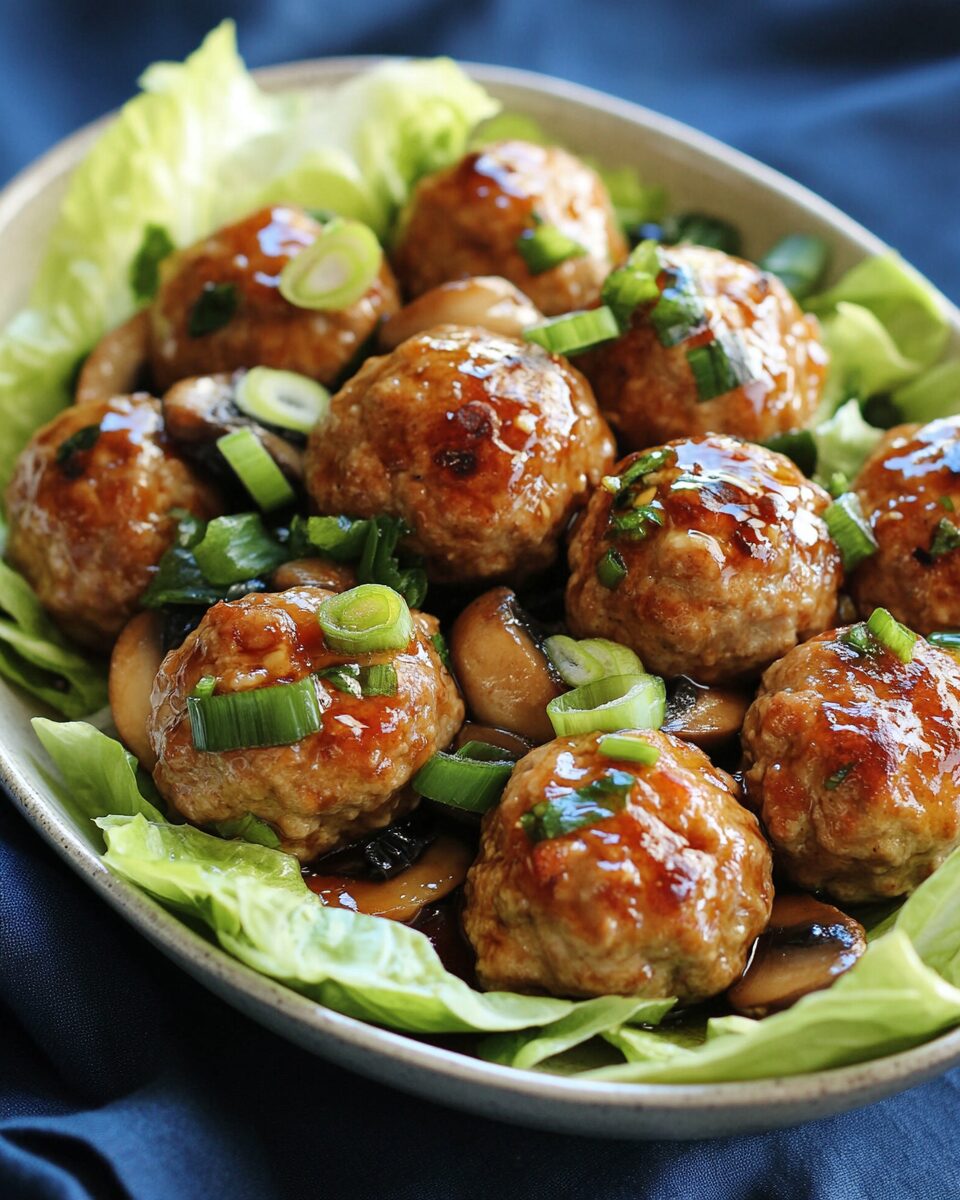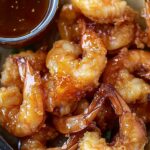Lion’s Head Meatballs, a signature dish from Chinese Huaiyang cuisine, are giant, tender meatballs made with pork and chicken, simmered in a fragrant broth with Napa cabbage and shiitake mushrooms. With a combination of deep-frying and slow simmering, these meatballs are juicy, flavorful, and perfect for a comforting meal served with steamed rice.
Full Recipe:
Ingredients
For the Meatballs:
- 2 stalks scallions (save some green parts for garnish)
- 1 thumb-sized piece of ginger
- 400 g minced pork (with 20% fat or higher)
- 100 g minced chicken
- 2 tablespoons Shaoxing rice wine
- 2 tablespoons light soy sauce
- ½ teaspoon salt
- ½ teaspoon sugar
- ½ teaspoon sesame oil
- 1 large egg
- 1 tablespoon cornstarch
- 60 g water chestnuts, minced (about 10 canned)
- Cooking oil for deep frying
For the Soup:
- 7 Napa cabbage leaves, cut in halves
- 6 large dried shiitake mushrooms (soaked in 500 ml water overnight)
- ½ tablespoon dried shrimp (optional)
- ¼ teaspoon salt
- 1 pinch white pepper
Directions
1. Prepare the Meatball Mixture:
- Cut scallions and ginger into sections and soak in 6 tablespoons of warm water; let cool.
- In a mixing bowl, combine pork, chicken, Shaoxing wine, soy sauce, salt, sugar, sesame oil, egg, and cornstarch.
- Stir the mixture in one direction, adding the scallion-ginger water gradually until fully absorbed. Mix in minced water chestnuts.
2. Shape and Fry the Meatballs:
- Heat oil in a deep pot to 180°C (360°F).
- Divide the meat mixture into 6 portions. Shape each portion into a ball using a small bowl and a spoon for smooth edges.
- Fry 1–2 meatballs at a time, turning gently for even coloring. Remove when golden brown and set aside.
3. Cook the Soup:
- Layer the white parts of the Napa cabbage in a pot and place the meatballs on top.
- Add shiitake mushrooms, soaking water (strain solids), scallion-ginger mix, and dried shrimp (if using). Season with salt and white pepper.
- Bring to a boil, reduce to low heat, and simmer for 15 minutes.
- Add the leafy cabbage and simmer for an additional 5 minutes.
4. Serve:
- Garnish with chopped scallions and serve warm with steamed rice.
Nutrients (Per Serving)
- Calories: 233 kcal
- Protein: 18 g
- Carbohydrates: 5 g
- Fat: 15 g
- Saturated Fat: 5 g
- Fiber: 2 g
- Sodium: 520 mg
- Sugar: 2 g
The Legacy of Lion’s Head Meatballs
Lion’s Head Meatballs have a storied history and are considered one of the pillars of Huaiyang cuisine. This dish is often served during festive occasions and family gatherings, symbolizing prosperity and unity. Its luxurious presentation and harmonious flavors make it a favorite for celebrations, yet its simplicity and accessibility allow it to shine as a comforting home-cooked meal.
Traditionally, these meatballs are made with fatty pork for a tender and juicy texture, but modern variations, like incorporating minced chicken, make the dish lighter while retaining its signature richness. The slow simmering process melds the flavors of the broth, cabbage, and meatballs, creating a dish that is both hearty and elegant.
The Art of Crafting the Perfect Meatballs
The heart of this dish lies in the preparation of the meatballs. A blend of pork and chicken provides the ideal balance of flavor and texture. The addition of water chestnuts adds a refreshing crunch, while scallion and ginger-infused water imparts a delicate aromatic note.
The technique of mixing the meat in one direction helps bind the ingredients and creates a smooth, cohesive mixture. Shaping the meatballs with care ensures an even texture, and deep-frying them before simmering adds a golden crust that locks in the juices, enhancing their overall flavor.
A Flavorful, Nourishing Broth
The broth for Lion’s Head Meatballs is a masterful example of Huaiyang cuisine’s emphasis on balance and clarity. Napa cabbage, shiitake mushrooms, and dried shrimp (optional) contribute to the dish’s layers of flavor. The mushrooms and shrimp add umami, while the cabbage absorbs the broth, becoming tender and flavorful.
The broth is seasoned with salt and white pepper to enhance the natural flavors of the ingredients. The simmering process allows the meatballs to infuse the broth, creating a rich, savory base that complements the dish’s components.
Serving and Pairing Suggestions
Lion’s Head Meatballs are traditionally served in a large communal pot, emphasizing the dish’s role as a centerpiece for family-style dining. Steamed jasmine rice is the perfect accompaniment, as it soaks up the flavorful broth and balances the richness of the meatballs.
For additional texture and variety, consider pairing this dish with lightly sautéed greens like bok choy or Chinese broccoli. A side of pickled vegetables or a simple cucumber salad can also provide a refreshing contrast to the dish’s hearty flavors.
Tips for Success
- Choose the Right Meat: Opt for pork with a higher fat content (about 20%) to ensure tender, juicy meatballs. The addition of minced chicken lightens the mixture while maintaining richness.
- Don’t Skip the Scallion-Ginger Water: This infused water is key to the meatballs’ flavor and texture, ensuring a tender and aromatic result.
- Fry with Care: Frying the meatballs adds a golden crust and locks in moisture. Avoid overcrowding the pot to ensure even cooking.
- Layer the Cabbage Strategically: Placing the cabbage at the bottom of the pot prevents the meatballs from sticking and ensures the cabbage absorbs the flavorful broth.
- Customize to Taste: Adjust the level of salt and pepper in the broth to suit your preferences. Adding dried shrimp enhances the umami flavor but can be omitted for a milder dish.
Why This Recipe Stands Out
Lion’s Head Meatballs are a showcase of Chinese culinary philosophy, where simplicity meets sophistication. This dish exemplifies the balance of flavors, textures, and techniques that define Huaiyang cuisine. The tender meatballs, savory broth, and delicate cabbage come together to create a dish that is satisfying, nourishing, and deeply comforting.
Whether served during a festive celebration or as a weeknight dinner, this recipe is a testament to the timeless appeal of traditional Chinese cuisine. Its ability to adapt to modern tastes and dietary preferences ensures its place on dining tables for generations to come.
Conclusion
Lion’s Head Meatballs are more than just a dish—they are a cultural and culinary treasure. Their rich flavors, tender texture, and elegant presentation make them a standout recipe for any occasion. By following this recipe, you can recreate this classic dish at home, bringing a taste of Huaiyang cuisine to your table.
Whether you’re sharing it with family or savoring it on your own, Lion’s Head Meatballs are a dish that warms the soul and celebrates the beauty of Chinese cooking. Enjoy this delightful journey of flavors and traditions with every bite.






